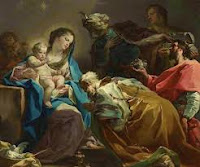In honor of the Epiphany (which just passed on January 6th) and because I'm writing a series on pain management with Chinese medicine, the herbs I'm featuring this month are frankincense & myrrh.
Most of us have heard of frankincense & myrrh as the gifts (along with gold) which the three Magi brought to the Baby Jesus. (As I've recently learned, the celebration of Epiphany marks, according to western Christians, the arrival of the Magi in Bethlehem.) The story of the Magi -- distinguished foreign gentiles who journey "from the East" to pay homage to Christ-child -- evokes awe-inspiring themes of cross-cultural communication and exchange.
Like the story of the Magi, frankincense and myrrh themselves evoke themes of migration and cross-cultural exchange. Both substances are tree resins. Long ago, traders from the Middle East traveled the Silk Road to bring these herbs to China.
In the West, frankincense and myrrh have been used for embalming, as incense, or as ingredients in cosmetics, fragrant oils and perfumes.
But how have they been used medicinally?
In China, frankincense and myrrh became prized for their effectiveness in healing injuries and wounds.
In his book A Tooth from the Tiger's Mouth: How to Treat Your Injuries with Powerful Healing Secrets of the Great Chinese Warriors, New York-based martial artist & acupuncturist, Tom Bisio, writes:
"The two herbs often appear together in herb formulas because they act synergistically to kill pain, crack blood stagnation, and regenerate flesh in cases of non-healing wounds. Xue jie (dragon's blood) is a reddish tree resin similar to frankincense and myrrh. It is also included in many injury formulas. Xue jie was used in Europe in the sixteenth and seventeenth centuries to reduce the pain of gout."
Though somewhat different in nature, frankincense and myrrh both function to:
- Break up blood stagnation and facilitate the movement of blood and circulation at the site of an injury,
- Alleviate pain,
- Reduce swelling, and
- Regenerate tissue and heal lingering sores.
Obviously, they are important injury-healers and should be a part of any sports medicine acupuncturist's first aid kit.
They're also useful in internal medicine. The alleviate epigastric and abdominal pain due to blood stagnation. In gynecology and obstetrics, they are useful in cases of amenorrhea, menstrual pain and postpartum pain. (Keep in mind that these internal pains can be due to causes other than "blood stagnation." Other herbs should be selected in these cases.) Frankincense and myrrh can also ease chronic rheumatic pain with inflammation and swelling, and break down and disperse necrotic and scar tissue.
Returning to the story of the Magi, one is tempted to think that these two precious resins were actually a perfect gift for the Virgin mother. A priority for promoting postpartum healing is to disperse and clear old, congealed blood from the uterus, reduce swelling and heal uterine tissue. Frankincense and myrrh might have been just the treasures that the New Mother needed.




